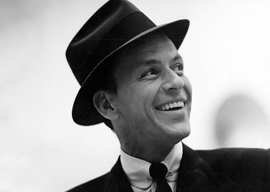
May 22, 2013

Frank Sinatra
The first beneficiary of America’s Italian Boom was a 28-year-old New Jersey native (and a student of the bel canto style of Italian opera singing) named Frank Sinatra. As a 15-year-old bobbysoxer, my late mother-in-law saw Sinatra sing at an 11 AM show in 1945, one of nine performances the old pro turned overnight sensation was doing per day in Chicago. It seems odd that the first teen idol, the predecessor of Justin Bieber, was the weathered Sinatra, but it makes sense in the context of the sudden American infatuation with all things Italian.
American palates also benefited. French cuisine had long been fashionable in America, but it was always marketed as a formal luxury. The postwar American affection for cheap but tasty Italian food was immortalized in the spaghetti-eating scene in the 1955 Disney feature Lady and the Tramp.
Italian movies likewise found an audience in America. As a symbol of newfound American sophistication, voluptuous Italian starlets proved especially popular. In 1961, Hollywood gave the Best Actress Oscar to Sophia Loren for the Italian-language movie Two Women about the Marocchinate of 1944. (By the way, this now neglected event helps explain why the Italians were less enthusiastic about postwar North African immigration than northern European countries: In 1944, a French general incentivized his Moroccan Muslim colonial troops to take Monte Cassino by promising them 50 hours to pillage and rape Italian civilians.)
The American impact on postwar Italy was subtler. In contrast to the Bush Administration, which was surprised in 2003 that overthrowing the Iraqi government would lead to looting, the Roosevelt Administration at least came up with a plan for Sicily.
To keep from slowing down General Patton’s tanks, certain members of the Sicilian-American community volunteered to have law and order in newly liberated Sicily maintained by their friends”i.e., friends who had friends. Perhaps these Sicilian men of respect had not been particularly active in public affairs since Mussolini’s crackdown on the Mafia, but they were ready to take up their pre-fascist responsibilities in the new post-fascist order.
The Roosevelt Administration’s revival of the Sicilian Mafia in 1943 didn’t do postwar Italy much good, but it at least had positive payoffs in the quality of American movies from the 1970s onward.